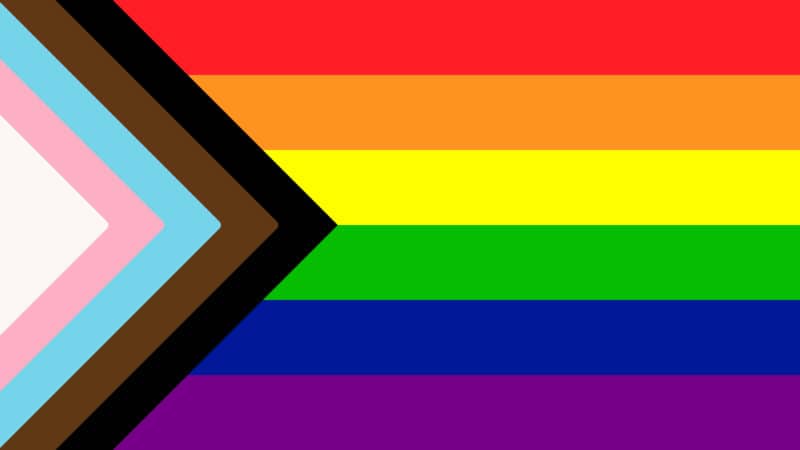In 2020, Professor Sir Simon Baron-Cohen reported that 42 – 69% of autistic people identify as LGBTQ+. This extends beyond the autistic community, with children and teens with ADHD being reported to explore their gender identity and sexuality with greater immediacy and increased feelings of overwhelm and hyperfocus (Dr Sharon Saline and Julie Mencher, 2021).
The question then remains: Why is there such an increased overlap between the neurodivergent and LGBTQ+ community? Based on our own experiences and research, these are some of our suggestions:
Coming out

Although we associate coming out primarily with the LGBTQ+ community, it could be argued that the ‘coming out process’ could be likened to the ‘disclosure’ of neurodivergence in education and the workplace. Professor Amanda Kirby (Do-IT Solutions) suggests that the language of disclosure, revealing and ‘coming out’ is not exclusive to the field of neurodiversity, but in other worlds that intersect parts of who we are, particularly when these are unseen or unobserved differences.
Gender norms

It has been well documented, particularly within the online autistic community, that neurodivergent people are more likely to question the typical sexual and gender norms of society, than neurotypical people. Lydia X. Z. Brown, a prominent figure in the autistic and transgender community, suggested that a significant proportion of the autistic community identify as trans, genderqueer, non-binary or genderless, because many neurodivergent people are less aware of, or less susceptible to societal pressure and gender forms, due to the traits and characteristics of their neurodivergence.
Finding a cure

Unfortunately, there are similar ‘cure’ agendas associated with both the neurodivergent (particularly autistic) and LGBTQ+ community. In ways that parallel the Medical Model of Disability, medical practitioners of the 19th century used pseudoscientific techniques to subjugate LGBTQ people’s sexuality and gender identity and make them conform to society’s expectations of how they should behave (known as conversion therapy). Only last year, the UK government made plans to bring forward the ban on conversion therapy, meaning that until 2021, many forms of this practice were still available, and used. Unfortunately, this ban will only cover sexual orientation-based therapy but will not ban conversion therapy for transgender people.
Rates of conversion therapy appear to be higher in those from Christian and Muslim faiths, as well as for those from minoritized ethnic communities.
Much like conversion therapy, the ‘cure’ agenda in relation to neurodivergence has focused on finding ‘cures’ for conditions such as autism and ADHD. These include harmful methods, including the use of chemicals, pseudoscientific medicines, neurofeedback, and oxygen therapy. It is now widely known that neurodivergent conditions are neurological, they are either established at birth, or caused as a result of a brain trauma or injury. For this reason, although there are coping strategies that can be implemented to alleviate certain traits of neurodivergent conditions, the condition cannot be fully cured.
Sensory experiences

An evolving conversation surrounds the link between gender dysphoria and the sensory system. In particular, the ‘sense of bodily autonomy’ could be a reason why there are lots of transgender neurodivergent people. Baron-Cohen et al. (2020) found that transgender and gender diverse people are six times more likely to be autistic. In a study by Dr Laura Case, it appears that dysphoria related to gender-incongruent body parts (such as breasts) in Female to Male transgender people is tied to the sensory system in the brain. This is in comparison to a gender-congruent body part, such as a hand.
This could be further compounded by some of the activities involved for lots of transgender and non-binary people, such as binding.
Self-identification

Gender identity and neurodivergence can both be self-identified. Diagnosis and gender affirming procedures are often expensive (or have long, inaccessible waiting lists). Gender affirming surgeries and hormone treatment often have to be funded by charity models (e.g., GoFundMe pages) and private diagnosis for neurodivergence can be equally expensive.
Furthermore, the Equality Act, particularly for neurodivergent people, applies even if a person is not formally diagnosed with a condition. The specific wording of the act is ‘whether you describe yourself as having a disability’. Similarly for transgender people, the person does not need to have undergone any specific treatment or surgery to transition from their birth sex to their preferred gender to be protected under the Equality Act.
Some people self-identify in opposition to the medicalisation of neurodivergence, and instead, have a desire to be validated for who they are without medical diagnosis or ‘labelling’. Much like the opposition to the ‘cure’ agenda, most LGBTQ+ and neurodivergent people simply want to be accepted for who they are. For many, they don’t feel they need a medical diagnosis or any medical changes to their physical appearance to do this (particularly non-binary or agender people).
Therefore, self-identification is enough.
Safe communities and the rainbow flag

In an attempt to discourage the use of puzzle piece symbols in relation to autism (specifically), the Autism Rights movement introduced the use of a rainbow infinity symbol. Despite one being a symbol, and one being a flag, the use of a ‘rainbow’ has clear overlaps between the neurodivergent community and the LGBTQ+ community and creates a sense of cohesion and safety between the two communities.
References
Professor Sir Simon Baron-Cohen and colleagues https://www.cam.ac.uk/research/news/autistic-individuals-are-more-likely-to-be-lgbtq
https://onlinelibrary.wiley.com/doi/10.1002/aur.2604
Dr Sharon Saline and Julie Mencher – https://www.additudemag.com/gender-identity-adhd-supporting-children/
Professor Amanda Kirby – https://doitprofiler.com/insight/is-neurodiversity-coming-out-in-2021-and-should-we-have-to/
Lydia X. Y. Brown – https://www.autistichoya.com/2020/05/gendervague-at-intersection-of-autistic.html
Dr Laura Case – https://pubmed.ncbi.nlm.nih.gov/27646840/
=

